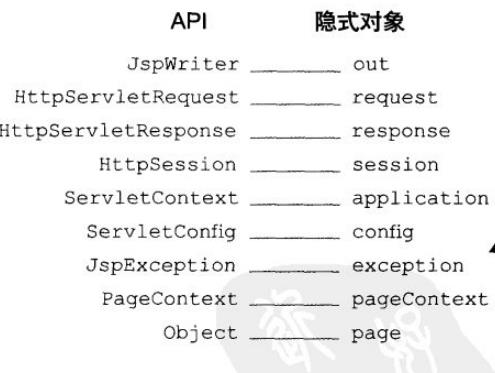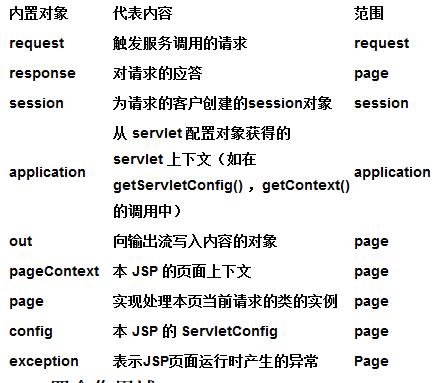JSP的九大内置对象和四个作用域
Posted
tags:
篇首语:本文由小常识网(cha138.com)小编为大家整理,主要介绍了JSP的九大内置对象和四个作用域相关的知识,希望对你有一定的参考价值。
JSP的九大内置对象: page,application,session,request,response,out,exception,config,pageContext. JSP的四个作用域:application,session,request,page.
|
1
2
3
4
5
6
7
8
9
10
11
12
13
14
15
16
17
18
19
20
21
22
23
24
25
26
27
28
29
30
31
32
33
34
35
36
37
38
39
40
41
42
43
44
45
46
47
48
49
50
51
52
53
54
55
56
57
58
59
60
61
62
63
64
65
66
67
68
69
70
71
72
73
74
75
76
77
78
79
80
81
82
83
84
85
86
87
88
89
90
91
92
93
94
95
96
97
98
99
100
101
102
103
104
105
106
107
108
109
110
111
112
113
114
115
116
117
118
119
120
121
122
123
124
125
126
127
128
129
130
131
132
133
|
//附上jsp转换成servlet后的java代码package org.apache.jsp;import javax.servlet.*;import javax.servlet.http.*;import javax.servlet.jsp.*;import java.util.*;public final class index_jsp extends org.apache.jasper.runtime.HttpJspBase implements org.apache.jasper.runtime.JspSourceDependent { int count = 0; int getCount(){ int num = 100; return num = 100*count; } private static final JspFactory _jspxFactory = JspFactory.getDefaultFactory(); private static java.util.List _jspx_dependants; private javax.el.ExpressionFactory _el_expressionfactory; private org.apache.AnnotationProcessor _jsp_annotationprocessor; public Object getDependants() { return _jspx_dependants; } public void _jspInit() { _el_expressionfactory = _jspxFactory.getJspApplicationContext(getServletConfig().getServletContext()).getExpressionFactory(); _jsp_annotationprocessor = (org.apache.AnnotationProcessor) getServletConfig().getServletContext().getAttribute(org.apache.AnnotationProcessor.class.getName()); } public void _jspDestroy() { } public void _jspService(HttpServletRequest request, HttpServletResponse response) throws java.io.IOException, ServletException { PageContext pageContext = null; HttpSession session = null; ServletContext application = null; ServletConfig config = null; JspWriter out = null; Object page = this; JspWriter _jspx_out = null; PageContext _jspx_page_context = null; try { pageContext = _jspxFactory.getPageContext(this, request, response, null, true, 8192, true); _jspx_page_context = pageContext; application = pageContext.getServletContext(); config = pageContext.getServletConfig(); session = pageContext.getSession(); out = pageContext.getOut(); _jspx_out = out; out.write(‘\r‘); out.write(‘\n‘);String path = request.getContextPath();String basePath = request.getScheme()+"://"+request.getServerName()+":"+request.getServerPort()+path+"/"; out.write("\r\n"); out.write("\r\n"); out.write("<!DOCTYPE HTML PUBLIC \"-//W3C//DTD HTML 4.01 Transitional//EN\">\r\n"); out.write("<html>\r\n"); out.write(" <head>\r\n"); out.write(" <base href=\""); out.print(basePath); out.write("\">\r\n"); out.write(" \r\n"); out.write(" <title>My JSP ‘index.jsp‘ starting page</title>\r\n"); out.write("\t<meta http-equiv=\"pragma\" content=\"no-cache\">\r\n"); out.write("\t<meta http-equiv=\"cache-control\" content=\"no-cache\">\r\n"); out.write("\t<meta http-equiv=\"expires\" content=\"0\"> \r\n"); out.write("\t<meta http-equiv=\"keywords\" content=\"keyword1,keyword2,keyword3\">\r\n"); out.write("\t<meta http-equiv=\"description\" content=\"This is my page\">\r\n"); out.write(" </head>\r\n"); out.write(" \r\n"); out.write(" <body>\r\n"); out.write(" "); out.write("\r\n"); out.write(" \r\n"); out.write(" "); out.write("\r\n"); out.write(" \r\n"); out.write(" "); out.print(++count ); out.write("\r\n"); out.write(" "); out.print( getCount() ); out.write("\r\n"); out.write(" <form action=\"test.do\" method=\"post\">\r\n"); out.write(" <select name =\"color\">\r\n"); out.write(" <option>White</option>\r\n"); out.write(" <option>Red</option>\r\n"); out.write(" <option>Yellow</option>\r\n"); out.write(" <option>Blue</option>\r\n"); out.write(" </select>\r\n"); out.write(" \r\n"); out.write(" <input type=\"checkbox\" name=\"hobby\" value=\"football\">football<br>\r\n"); out.write(" <input type=\"checkbox\" name=\"hobby\" value=\"football\">basketball<br>\r\n"); out.write(" <input type=\"checkbox\" name=\"hobby\" value=\"football\">baseball<br>\r\n"); out.write(" \r\n"); out.write(" <input type=\"submit\">\r\n"); out.write(" </form>\r\n"); out.write(" </body>\r\n"); out.write("</html>\r\n"); } catch (Throwable t) { if (!(t instanceof SkipPageException)){ out = _jspx_out; if (out != null && out.getBufferSize() != 0) try { out.clearBuffer(); } catch (java.io.IOException e) {} if (_jspx_page_context != null) _jspx_page_context.handlePageException(t); } } finally { _jspxFactory.releasePageContext(_jspx_page_context); } }} |
application作用域就是服务器启动到关闭的整段时间,在这个作用域内设置的信息可以被所有应用程序使用。application作用域上的信息传递是通过ServletContext实现的.
session作用域比较容易理解,同一浏览器对服务器进行多次访问,在这多次访问之间传递信息,就是session作用域的体现,
一个HTTP请求的处理可能需要多个Servlet合作,而这几个Servlet之间可以通过某种方式传递信息,但这个信息在请求结束后就无效了。Servlet之间的信息共享是通过HttpServletRequest接口的两个方法来实现的。
page对象的作用范围仅限于用户请求的当前页面,对于page对象的引用将在响应返回给客户端之后被释放,或者在请求被转发到其他地方后被释放。对page对象的引用通常存储在pageContext对象中。
以上是关于JSP的九大内置对象和四个作用域的主要内容,如果未能解决你的问题,请参考以下文章


